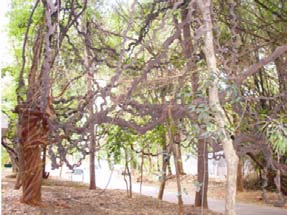|
Home
Introduction Materials and methods Results and discussion Conclusions Acknowledgement References |
|
In this issue
A giant liana in an alien
environment Large branchiopods The special section is the outcome of the Sixth International Large Branchiopods Symposium organized by the Acharya Nagarjuna University, Nagarjuna Nagar, in September 2007 at Vijayawada (see Curr Sci., 2008, 94, 164–165). As a major class of Crustacea, the branchiopods are comprised of calm shrimps, fairy and brine shrimps and tadpole shrimps. They inhabit unstable ephemeral inland and brackish waters. Describing the distribution of 35 species of clam shrimps in India, M. K. Durga Prasad and G. Simhachalam (page 71) indicate the endemicity of 32 species. Summarizing his 20 years of intense field studies, B. V. Timms (page 74) explains the unusual species richness and the amazing halophilic branchiopods of Australia. Using molecular markers, R. Tizol- Correa et al. (page 81) trace the phylogenetic relationships of the brine shrimps from tropical salt-pans of Mexico and Cuba. From an experimental interspecific hybridization study of the African fairy shrimps, H. J. Dumont and Els Adriaens (page 88) report that the rate of evolution in these fairy shrimps has remained unusually slow. To tide over the unfavourable dry season, these animals adopt different patterns of reproduction; some are bisexual, while others display a wide range of sexuality and modes of reproduction. In the Mexican waters, H. Garcia-Velazco et al. (page 91) record the occurrence of parthenogenetic females and cross-fertilizing hermaphrodites in the tadpole shrimp population. From an experimental study, S. C. Weeks (Akron University, USA, page 98) suggests that males introduced into the population by an amphigenic hermaphrodite can be sustained for a few generations. These creatures are also capable of generating drought-resistant cysts; for instance, the cysts of the brine shrimp alone are known to synthesize and store two unique hitherto unknown proteins called Artemin and p26. These proteins withstand the thus for unknown minimal residual water of 0.7 μg/g cyst and when hydrated (1 million times) 0.7 g water/g cyst. N. Munuswamy et al. (page 103) have recorded their presence in the cysts of the Indian fairy shrimp. Besides this, the branchiopods adopt a sort of bet-hedging strategy by hatching only a cohort of the accumulated cysts bank, when pools are filled with rainwater. All developing countries practising aquaculture import Artemia cysts from USA. For instance, to feed 1000 million hatchings of shrimp cultivated for export, India imports 100 tonnes of Artemia cysts at the cost of Rs 560 million. Some companies fill up deliberately commercial brine shrimps cysts with different shrimp species and thereby introduce unsolicited Artemia, which may hybridize with native species. To identify such a ‘contaminant’, R. Campos- Ramos et al. (page 111) describe a bio-kinetic range of cyst-hatching temperatures for Artemia spp. C. Arulvasu and N. Munuswamy (page 114) have shown that Artemia nauplii can also be enriched with growthpromoting polyunsaturated fatty acid by soaking the larvae in 0.5% shrimp head oil emulsion for a period of 9 h. In an ingenious study, C. Orozco- Medina et al. (page 120) have shown that the metanauplii of Artemia ingested bacterial cells. Thus, the special section highlights the academically interesting and economically useful large branchiopods. T. J. Pandian |
| E-mail | Sahyadri | ENVIS | Energy | GRASS | CES | IISc | E-mail |
